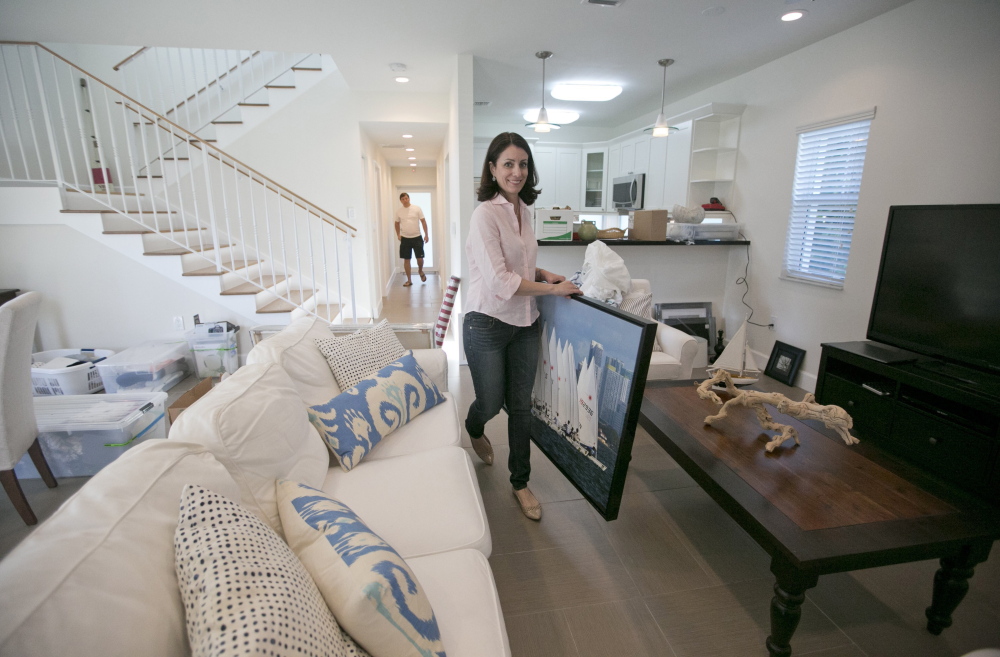MIAMI — Carlos Ruiz de Quevedo worked nearly two years to design and build a “green” home in a gentrifying section of the Little Gables, a labor of love for the architect and Realtor, with energy-saving features like energy-efficient impact windows, a solar-ready electrical system, and highly insulated walls and roof.
The two-story house has environmentally friendly details like cisterns that collect rainwater and air-conditioner runoff for watering the lawn, and it’s wired for an electric car charger.
So when Ruiz de Quevedo listed the three-bedroom, three-bath house at $625,000, aiming to tap into the peak spring/summer house-hunting season, he hired a home staging company to furnish the place.
“They even put in a make-believe family to live in the place,” said Ruiz, who bought the property in June 2012 with a run-down coral rock cottage that was beyond saving.
“There is a lot of competition, so you want your house to stand out,” said Marisa Salas, who owns the South Florida franchise of Showhomes. “We stage all the rooms so people can envision how spaces are meant to be utilized.”
In the current strong housing market, Salas said, her company is seeing growing demand for staging services. She furnishes the homes, places art on the walls and adds homey touches.
When Salas started out in the business during the downturn, “there were a lot of vacant properties,” which made home-management services particularly appealing to owners. Besides staying on top of maintenance, the property manager helps ensure that squatters don’t move in.
Staged homes fetch 5 percent to 15 percent more than those left vacant, according to Salas. The staged homes also sell faster than those that aren’t, she added.
“We create the emotional aspect of a house. When people walk into a vacant house, they don’t really appreciate anything,” she said.
Home sellers tap “stagers” primarily for higher-end homes, in “the $1 million to $3 million range,” Salas said. Fees typically run $3,000 to $10,000, depending on the home.
While some people have great visualization skills to imagine the potential of a room or a space, they are more the exception than the rule, Realtors say, so it’s helpful to spell out a home’s features and options.
“Many people are losing their ability to visualize. We want them to come in and visualize themselves living in the house. We know we’ve got you when you say, ‘Oh, the TV will go here,’” said Ruiz de Quevedo.
“I had a lady tell me her 50-inch TV wouldn’t fit in this space,” said Ruiz de Quevedo, gesturing at a wall with more than ample room.
At the Little Gables house, a home manager moved in late in April and plans to stay in the home until it sells.
The manager, David Hein, is from Ohio and living temporarily in South Florida so his son, David Hein, can train in a sailing campaign for the 2016 Olympics. The Little Gables stint marks his fourth house.
In exchange for managing the home, Hein gets to live there at a reduced rent – about one-third the market rate, Salas said.
That helps to reduce the holding cost for the seller. Hein will also have to pay the utilities.
“Here, you’ll be very happy with the electric bill,” Ruiz de Quevedo told Hein as the house was being furnished recently.
Ruiz de Quevedo expects the monthly electric bill on the 1,941-square-foot house to be in the range of $30 to $60 a month, “if they use as I do.”
“If they install solar panels for hot water and to generate power, this house can be energy-neutral or receive a check from FPL,” Ruiz de Quevedo added.
The water heater works on-demand. A high-efficiency air-conditioning system reduces humidity to make the house feel more comfortable without as much chilling.
Ruiz de Quevedo, a Realtor with EWM Realty International in Coral Gables, is hoping to find a young couple interested in the special features the home offers. He sounds like he’s looking more for a kindred spirit than just an average buyer.
For one thing, the features added to construction costs. And Ruiz de Quevedo is eager to monitor the home’s energy use to evaluate its performance. He built a second home next door and is mulling whether to sell that now or to hang on to it to monitor the performance of its energy-efficient features.
The home manager’s responsibilities include keeping the home safe, clean and secure so that it is shipshape whenever prospective buyers take a tour.
“One dead roach on the floor can kill a sale,” said Ruiz de Quevedo.
The manager has to strike a balance: to make the home feel alive, with food in the pantry and refrigerator, but with everything as well organized as a Container Store display.
“We train our managers,” said Salas. “No toiletries all over the place. No dirty dishes.”
Send questions/comments to the editors.



Success. Please wait for the page to reload. If the page does not reload within 5 seconds, please refresh the page.
Enter your email and password to access comments.
Hi, to comment on stories you must . This profile is in addition to your subscription and website login.
Already have a commenting profile? .
Invalid username/password.
Please check your email to confirm and complete your registration.
Only subscribers are eligible to post comments. Please subscribe or login first for digital access. Here’s why.
Use the form below to reset your password. When you've submitted your account email, we will send an email with a reset code.